Introduction
Moomoo vs Robinhood isn’t just a question of which trading app looks better, it’s about which one actually aligns with the way you invest.
At a glance, both offer a mobile-first experience, fast trade execution, and enough tools to get started. But once you go beyond the interface, the differences become hard to ignore.
Robinhood is built around simplicity and accessibility, with features aimed at new investors and crypto users.
Moomoo takes a different approach offering deeper analytics, access to global markets, and tools that cater to more active, detail-oriented traders.
This guide breaks it all down features, tools, execution, market access, and who each platform is truly built for.
If you’re deciding between Moomoo and Robinhood, this is the side-by-side comparison that shows you exactly where they differ and which one gives you the edge.
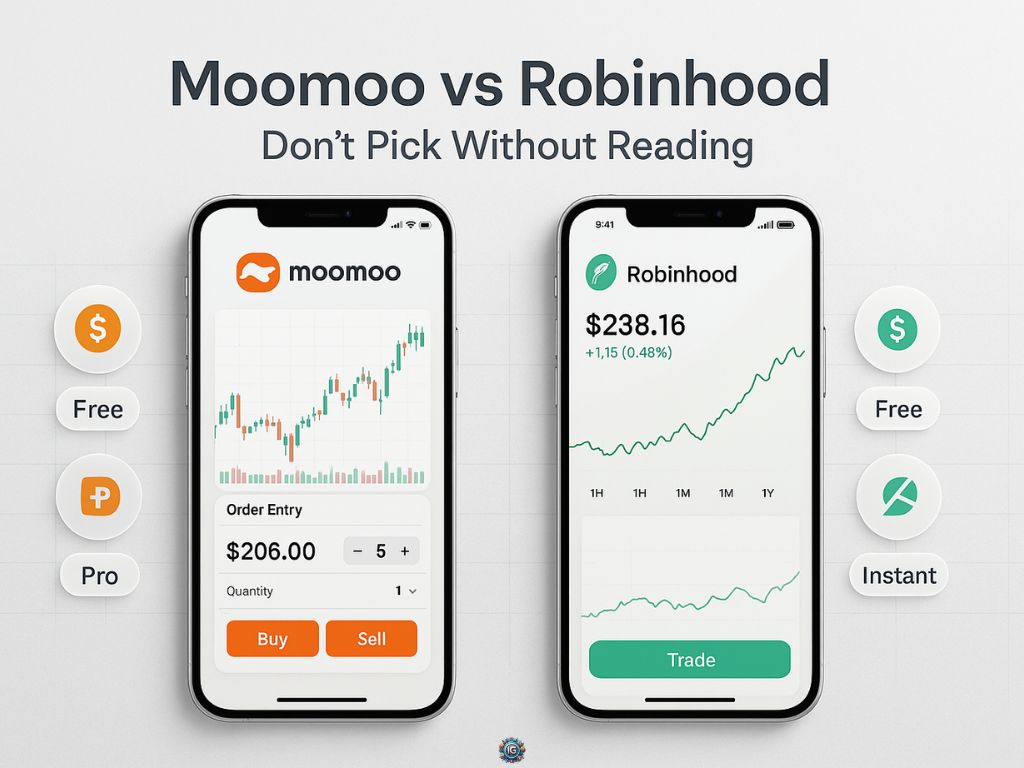
Key Takeaways
- Robinhood is built for simplicity clean UI, fast onboarding, and access to stocks, options, and crypto in one place.
- Moomoo targets active traders with advanced charting, in-depth analytics, and access to U.S. and Asia-Pacific markets.
- Robinhood supports fractional shares and direct crypto trading, while Moomoo offers paper trading, IPO access, and Level 2 market data.
- Both offer mobile-first platforms, but Moomoo has the edge in research tools, technical indicators, and market depth.
- Choose Robinhood if you want a fast, minimal app with integrated crypto and a lower learning curve.
- Choose Moomoo if you’re focused on data, technical setups, or international market exposure — and don’t need hand-holding.
Quick Comparison at a Glance
| Feature | Moomoo | Robinhood |
| Target User | Active traders, data-driven investors | Beginners, casual investors |
| Asset Access | U.S., Hong Kong, China A-shares | U.S. stocks, ETFs, options, crypto |
| Crypto Support | ❌ No direct trading (U.S. users) | ✅ Direct crypto trading supported |
| Options Trading | ✅ Yes, $0 per contract | ✅ Yes, $0 per contract |
| Fractional Shares | ❌ Not supported | ✅ Available |
| Charting Tools | Advanced technical indicators, drawing tools | Basic charts, fewer customizations |
| Research & Analytics | Built-in screeners, earnings calendars, Level 2 | Limited research tools, third-party headlines |
| Paper Trading | ✅ Yes | ❌ Not available |
| Global Markets | ✅ Yes (APAC region) | ❌ U.S. only |
| Mobile App UX | Feature-dense, customizable | Clean, simplified, beginner-friendly |
| Account Types | Margin/cash accounts, IPO eligibility | Individual brokerage only |
| Best For | Traders who rely on data & multi-market access | Users who want speed, ease, and crypto in-app |
Moomoo vs Robinhood: Fee Structures & Pricing
At face value, both Moomoo and Robinhood promote cost-effective trading. But behind the “no commission” headlines, the real differences show up in margin rates, spread mechanics, and hidden exit costs that can sneak up on active users.
Let’s break it down where it counts.
Trading Commissions: No Surprise Here
Both platforms offer $0 commission trading on U.S. stocks, ETFs, and options. You won’t pay a base fee just to place a trade that’s standard across the industry now.
But don’t let the zero fool you. Your cost structure still matters, especially when you start adding crypto, leverage, or account transfers into the equation.
Options Trading: Same Headline, Slightly Different Context
- Moomoo charges $0 per contract, with no platform fees.
- Robinhood also charges $0 per contract a rare move for a mainstream U.S. broker.
The difference?
Moomoo provides more control over advanced order types and better order visualization, while Robinhood keeps it bare-bones. If you’re placing complex option legs or tracking Greeks, Moomoo gives you more tools to justify the trade.
Margin Rates: Where the Real Cost Shows Up
- Moomoo: Margin interest starts at 6.8% APR, depending on your account size.
- Robinhood: Requires Robinhood Gold ($5/month) for margin access. After your first $1,000 of margin, the APR jumps to 8%.
Translation?
If you’re regularly trading on margin, Moomoo is clearly cheaper especially over time or on larger balances.
Robinhood’s flat $5/month subscription may look simple, but it adds up and includes baked-in limitations.
Crypto Trading Fees: Access vs Cost
- Robinhood: You can buy and sell crypto directly, with no visible commission. But make no mistake — you’re paying a spread markup, typically around 1–1.5%.
- Moomoo: Offers no crypto trading (for U.S. users), though the parent company supports it in other regions.
Bottom line?
Robinhood wins if you want crypto access inside your trading app just know that every trade carries a silent tax in the spread. Moomoo simply isn’t an option here for U.S. crypto investors.
Transfer & Withdrawal Fees: The Fine Print
- Moomoo: ACH transfers are free. Wire transfers may carry fees. ACAT outbound transfers are $75.
- Robinhood: Also charges $75 for ACAT transfers. ACH withdrawals are free, but instant withdrawals (to a debit card) may trigger small fees depending on your bank.
So what?
If you ever plan to move your money off the platform, those ACAT fees are identical and unavoidable. But if you prefer faster withdrawals, Robinhood has the edge with more flexible options.
So, Which Is Cheaper?
It depends on how you trade:
- Buy-and-hold U.S. stocks and options? Nearly a tie.
- Margin user or advanced options trader? Moomoo is cheaper and offers more control.
- Crypto-curious or want quick cashouts? Robinhood offers access but make peace with the spreads.
Neither platform is “free.”
But one costs you more in subscription upsells. The other hides your fees in spread slippage or limited visibility.
🔥 This is where the fine print becomes your edge or your blind spot.

Moomoo vs Robinhood: Supported Assets & Markets
This is where Moomoo and Robinhood start to diverge fast not in what they offer on the surface, but in how far your money can actually go.
If you plan to diversify beyond U.S. stocks or explore international markets, crypto, or advanced instruments one platform clearly opens more doors than the other.
Here’s what matters.
Stocks & ETFs
Both platforms offer full access to U.S.-listed stocks and ETFs, with real-time quotes and zero-commission trading.
But that’s just the baseline.
- Robinhood: Focuses exclusively on U.S. equities. No access to international markets.
- Moomoo: Offers trading in U.S. markets, Hong Kong stocks, and China A-shares directly from the same app (for eligible accounts).
What that means: If you want exposure to Asia-Pacific markets without opening separate brokerage accounts or paying international transfer fees, Moomoo has the edge and it’s not close.
Options Trading
Both support basic and advanced options trading, with $0 contract fees.
- Moomoo provides multi-leg strategies, volatility metrics, and deeper options data overlays.
- Robinhood keeps it simple: clean interface, basic strategies, and less control over execution.
In short: If you’re running iron condors or multi-leg setups, Moomoo gives you more granularity. If you’re casually buying puts and calls? Either will do.
Cryptocurrency
- Robinhood: Offers direct crypto trading, including BTC, ETH, DOGE, and more — all from within the app.
- Moomoo: ❌ No crypto support for U.S. users (global parent company offers it elsewhere).
If crypto access matters, Robinhood is the obvious choice.
But just remember: you can’t withdraw your coins to a private wallet you’re trading IOUs, not actual assets.
IPO Access
- Moomoo gives eligible users access to select U.S. IPOs before public trading begins, via its parent company’s allocation system.
- Robinhood also provides IPO access but only for users on a waitlist basis, and allocations can be inconsistent.
If IPOs are part of your strategy, Moomoo offers slightly more reliability and transparency for gaining early access.
International Markets
- Moomoo: ✅ Trade directly on Hong Kong and China exchanges, plus U.S. markets
- Robinhood: ❌ U.S.-only. No foreign equities available.
If you want exposure to companies like Alibaba, Tencent, or international ETFs not listed in the U.S., Moomoo is built for that reach.
Final Word
- For U.S.-only traders, both apps give you what you need stocks, ETFs, and options.
- For crypto traders, Robinhood is your only option (with limits).
- For international market access, IPOs, or broader diversification, Moomoo is in a different league.
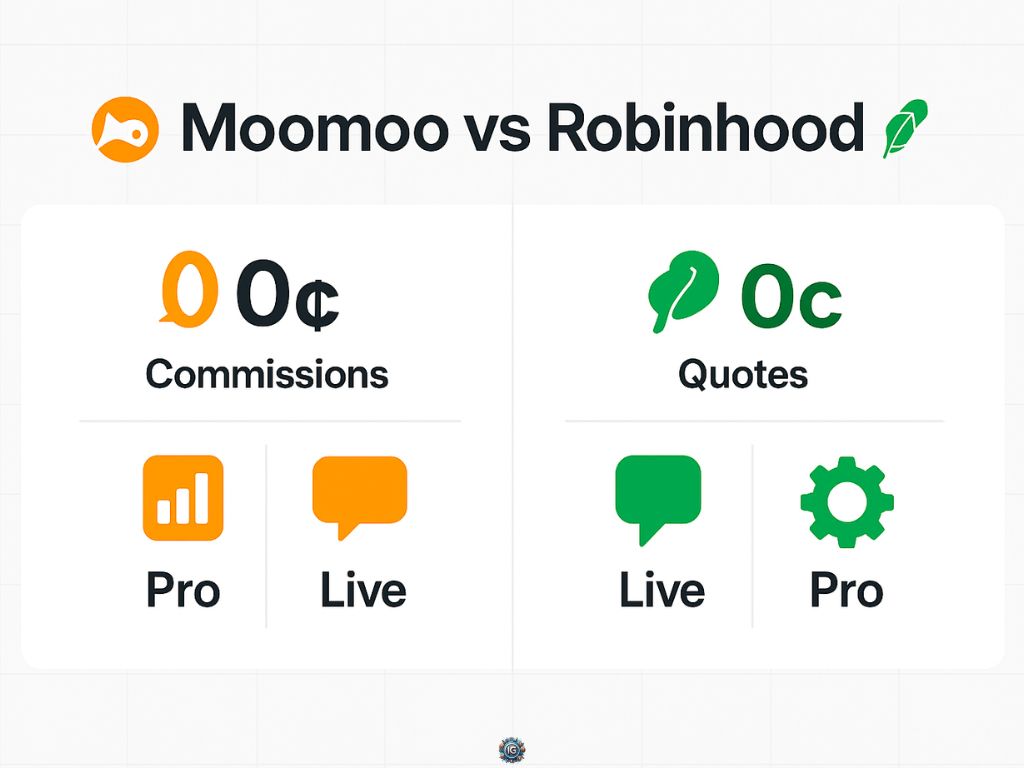
Moomoo vs Robinhood: Account Types & Minimums
When you’re choosing a trading platform, the type of account you can open and what you can do with it — matters as much as the interface itself. This is where Moomoo and Robinhood quietly shape your access, even if you’re not paying attention.
Here’s what you need to know before signing up.
Account Types
Robinhood keeps it simple:
- ✅ Individual taxable brokerage accounts only
- ❌ No joint, custodial, or retirement accounts
- ❌ No cash management sweep programs (past features discontinued)
- ✅ Robinhood Gold (premium add-on with research, margin, and interest on uninvested cash)
Moomoo offers more flexibility:
- ✅ Individual margin and cash accounts
- ✅ Access to IPO investing (for eligible users)
- ❌ No retirement accounts
- ❌ No joint or custodial options
- ✅ Paper trading mode for testing strategies without risk
Verdict: If you want a fast setup and don’t need multiple account types, Robinhood works.
If you’re planning to grow into IPO access or margin flexibility, Moomoo gives you more from the start — even if you’re not an advanced user yet.
Account Minimums
Robinhood:
- No account minimum
- $0 to start trading
- $1 minimum for fractional shares
- $2,000 minimum required for margin accounts (per FINRA)
Moomoo:
- $0 minimum to open an account
- No minimum to trade U.S. stocks
- $2,000+ required for full margin access
- Some international trades may require currency conversion thresholds
Verdict: Both platforms are beginner-friendly when it comes to starting balances but Moomoo’s international access may involve more complexity, especially if you’re trading across regions.
Pre-IPO Access
- Moomoo: Offers pre-IPO investing for eligible users, with real allocation systems based on demand and order size.
- Robinhood: IPO investing is available, but allocations are randomized and often oversubscribed.
If you’re interested in IPOs and want a systematic edge, Moomoo offers more consistent access with greater transparency.
Bottom Line
- If you just want to open an account, fund it, and start trading U.S. stocks both apps are frictionless.
- But if you’re thinking ahead to margin use, IPO access, or trading across multiple markets, Moomoo gives you room to grow.
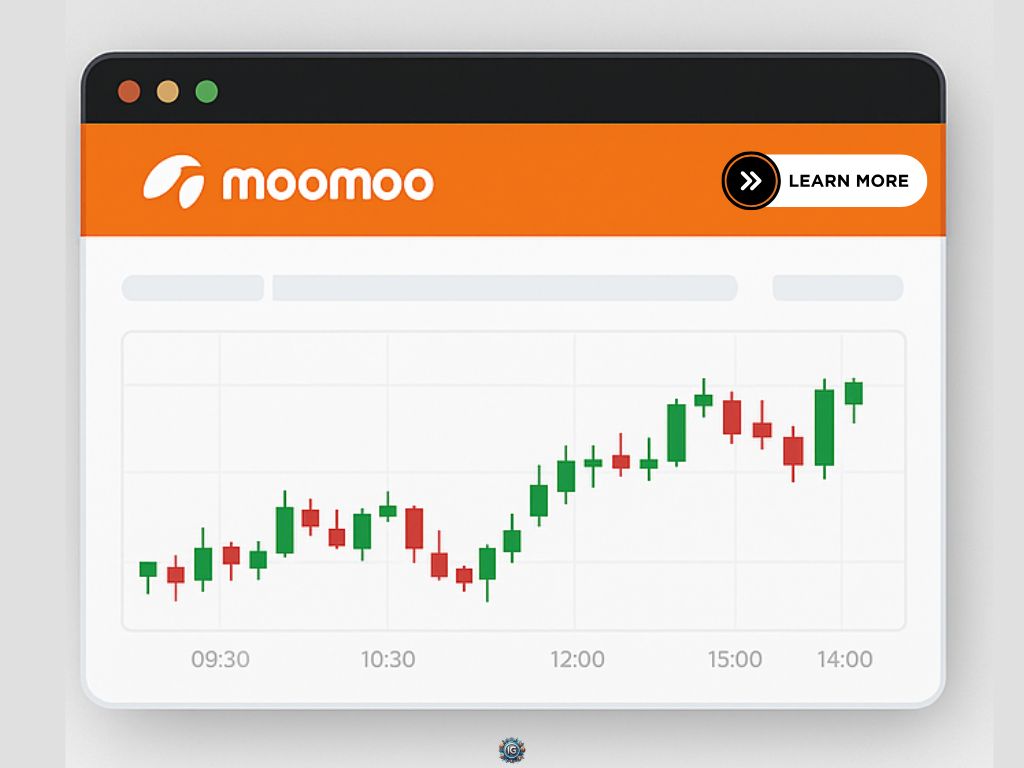
Moomoo vs Robinhood: Core Trading Experience
At this level, it’s not about whether the app works, it’s about how well it performs when it counts.
Order types, execution speed, and buying power all come into play when you’re reacting to market volatility, managing risk, or scaling trades. Here’s where Moomoo and Robinhood start to feel very different in the hands of an active trader.
Order Types & Execution Speed
Robinhood keeps order types simple:
- Market
- Limit
- Stop-loss
- Stop-limit
Execution is typically fast but users have no control over routing, and the platform has come under scrutiny in the past for payment for order flow (PFOF) practices that may prioritize profit over price improvement.
Moomoo offers a more advanced order suite:
- Market, Limit, Stop, Stop-limit
- Trailing stop orders
- OTO (One-Triggers-the-Other) orders
- GTC (Good-Til-Cancelled), Day, Fill-or-Kill options
- More visibility into order routing and execution transparency
Verdict: If you’re a casual trader placing market orders, Robinhood works. But if you care about execution logic, conditional orders, or trading around volatility, Moomoo gives you far more control and insight.
Fractional Shares & Buying Power
Robinhood supports fractional share investing across most U.S. stocks:
- Buy as little as $1 worth of a stock
- Great for new investors or high-priced stocks like Amazon or Tesla
- Fractional dividends reinvested automatically
Moomoo does not currently support fractional shares. All trades are placed in full-share increments, which may limit accessibility for small-balance users.
Verdict: If you’re investing small amounts or building a diversified portfolio on a budget, Robinhood has the advantage. Moomoo is better suited for traders with larger account sizes who care more about execution than micro-ownership.
Pre-Market & After-Hours Trading
Both platforms offer extended hours trading, but access varies.
Robinhood:
- Pre-market: 7:00 AM – 9:30 AM ET
- After-hours: 4:00 PM – 8:00 PM ET
- No customization on order routing during these sessions
Moomoo:
- Pre-market: 4:00 AM – 9:30 AM ET
- After-hours: 4:00 PM – 8:00 PM ET
- Deeper access into market maker routing, with Level 2 visibility during extended hours
Verdict: If you’re trying to trade earnings gaps or react to global news, Moomoo’s earlier pre-market access and routing transparency give it an edge.
Bottom Line
- Robinhood is designed for simplicity: fast trades, few choices, low learning curve.
- Moomoo is designed for control: more order types, deeper routing logic, better data during extended hours.
One favors ease. The other favors execution precision.
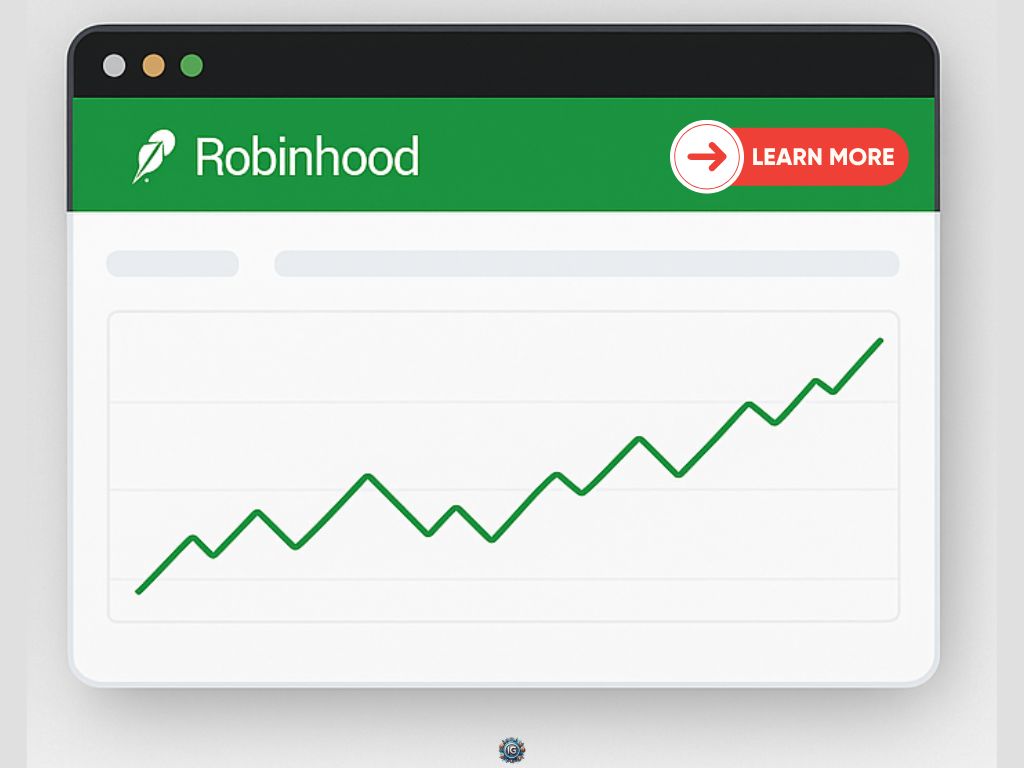
Moomoo vs Robinhood: Tools, Analytics & Research
You can’t trade what you can’t see and this is the category where platforms either empower you… or leave you guessing.
Robinhood has always been praised for its simplicity, but when it comes to deep research tools, charting, or screening, it plays defense.
Moomoo, on the other hand, leans into power-user territory with multi-layered data, heatmaps, and real-time technical overlays built into every screen.
Here’s how they stack up:
Interactive Charting & Technical Indicators
Robinhood:
- Clean, minimal charting
- Basic timeframes and price movement tracking
- No drawing tools
- No multi-indicator setups
- No candlestick pattern recognition or overlays
Moomoo:
- Fully interactive charts with drag-and-drop support
- Dozens of indicators including RSI, MACD, Bollinger Bands, VWAP
- Real-time candlestick analysis
- Trend lines, fib retracements, and annotation tools
- Multi-chart views and indicator stacking
Verdict: Moomoo is the clear winner for technical traders, it’s like having TradingView built into your brokerage app. Robinhood works for glancing at trends, not building setups.
Stock Screeners & Scanners
Robinhood:
- No native stock screener
- Limited discovery options based on trending, popularity, or themes
- Third-party research not fully integrated
Moomoo:
- Real-time screener with filter options:Price, volume, volatility, PE ratio, earnings date, short interest, and more
- Smart alerts for fundamental or technical conditions
- Custom scanner presets and real-time updates
Verdict: If you’re trading based on setups, not hype, Moomoo is built for scanning opportunities while Robinhood isn’t even trying.
News Feeds & Analyst Ratings
Robinhood:
- Basic headline stream
- Partnered with a few outlets (like Morningstar)
- Light on context, sentiment, or breakdowns
- Ratings shown, but not explained
Moomoo:
- Integrated news terminal with filters by ticker, sector, theme
- Real-time alerts for analyst upgrades/downgrades
- Earnings calendar, economic calendar, and sector rotation tools
- Social sentiment overlay with chart-based impact triggers
Verdict: Moomoo acts more like a Bloomberg terminal for retail Robinhood gives you headlines, but not insight.
Bottom Line
If you rely on data, indicators, or real-time scanning to find and time your trades Moomoo turns your screen into a trading desk.
If you’re buying because you saw something trending on Twitter, Robinhood will do just fine.

Moomoo vs Robinhood: User Interface & Mobile Experience
At this level, performance isn’t just about features, it’s about flow.
The best trading platform doesn’t just have powerful tools… it puts them exactly where you need them, with no lag, no clutter, and no confusion. This is where Moomoo and Robinhood go head-to-head in design philosophy.
Mobile App Usability
Robinhood:
- Ultra-clean layout, intuitive UX
- Built for swipe-first navigation
- Quick trade execution in 2–3 taps
- Simple dashboards, real-time price updates
- Less customization = fewer distractions
Moomoo:
- Feature-dense mobile app packed with charts, data feeds, and screeners
- Full trading workstation in your pocket
- Multi-tab layout can feel overwhelming at first
- Customizable widgets, indicator settings, alerts, and watchlists
- More powerful but with a learning curve
Verdict: If you’re new to trading or just want a clean, minimal app that “just works,” Robinhood is frictionless.
But if you want custom views, chart overlays, and institutional-level control, Moomoo’s mobile app turns your phone into a command center.
Web Platform Features
Robinhood:
- Streamlined browser platform
- Clean interface, but still lacks pro tools
- No multi-window layouts
- Best for checking positions, placing trades, and browsing trending stocks
Moomoo:
- Desktop-grade functionality
- Multi-screen charting, deep analytics, Level 2 integration
- Custom workspaces and hotkey setups
- Feels more like a terminal than a website
Verdict: Robinhood wins on simplicity. Moomoo wins on depth. If you’re a heavy desktop user or want your workstation to do more than just display price quotes, Moomoo is in a different league.
Final Word
- Robinhood delivers ease, speed, and instant accessibility.
- Moomoo delivers firepower with a learning curve that pays off.
If you want to scroll and trade, go Robinhood.
If you want to analyze, visualize, and optimize Moomoo is built for it.
Moomoo vs Robinhood: Funding, Withdrawals & Account Management
It’s easy to get excited about trading features until you try to move your money and realize you’re stuck in a waiting period, hitting limits, or paying surprise fees.
Here’s how Moomoo and Robinhood compare when it comes to funding speed, withdrawal access, and account flexibility.
Deposit Methods & Limits
Robinhood:
- Supports ACH bank transfers, debit cards (via Plaid), and direct deposit
- No fees for deposits
- Instant deposit availability:
- Up to $1,000 for standard users
- Up to $50,000 with Robinhood Gold (paid tier)
- No wire transfers or third-party funding options
Moomoo:
- Supports ACH, wire transfers, and third-party apps (like Wise for international users)
- No fee for ACH deposits
- Wire deposits may be required for larger funding
- No instant deposit funds clear in 1–3 business days
Verdict: Robinhood is faster for getting started, especially with instant deposit. Moomoo gives you more funding flexibility, but with slower settlement and stricter limits upfront.
Withdrawal Speed & Restrictions
Robinhood:
- ACH withdrawals: 1–3 business days
- Instant withdrawals to debit: available for a fee (typically 1.5%)
- Crypto withdrawals supported (with wallet verification)
- Full account transfers (ACAT): $75 fee
Moomoo:
- ACH withdrawals: 1–3 business days
- Wire withdrawals supported
- No crypto withdrawals (since crypto trading isn’t available)
- Full account transfer (ACAT): $75 fee
Key Watchout for Moomoo: Some users report temporary withdrawal holds for newly deposited funds especially via ACH. This can delay access to funds for up to 5 days.
Account Management Features
Robinhood:
- Minimalist design with basic account settings
- No built-in tax-loss harvesting or auto-investment tools
- Robinhood Gold unlocks additional features (margin, research, cash interest)
Moomoo:
- Deeper account customization (risk settings, alerts, margin preferences)
- No premium tier upsells, all trading tools included
- Supports extended account types and compliance tools for international users
Bottom Line
- If speed and simplicity matter especially for fast deposits or quick crypto withdrawals Robinhood is more streamlined.
- If you’re trading larger amounts, want wire options, or need more global account support, Moomoo offers more structure and control.

Moomoo vs Robinhood: Community, Education & Support
A trading app isn’t just about execution, it’s about how well it educates, supports, and connects its users.
Whether you’re just starting out or refining your strategy, the difference between a great experience and a frustrating one often comes down to how much help you can get and how fast.
In-App Learning Resources
Robinhood:
- Offers a dedicated Learn section with basic articles
- Educational content focuses on beginner topics: “What is a stock?”, “What is the S&P 500?”
- No structured curriculum or progress tracking
- Doesn’t tie learning directly into the trading experience
Moomoo:
- Built-in “Moo Learn” platform with articles, video tutorials, and quizzes
- Interactive modules tied to platform features (e.g., using indicators, paper trading strategies)
- Integrated with news alerts and platform tools learning is part of the experience
- Offers simulations alongside lessons for hands-on reinforcement
Verdict: Moomoo wins for serious learning, especially if you’re a self-starter who wants to evolve beyond surface-level definitions. Robinhood feels more like a content blog than an educational ecosystem.
Social Features & Chat Rooms
Robinhood:
- No built-in chat, sentiment tools, or community forums
- Relies on third-party social media traction (Reddit, Twitter, etc.)
- Isolated user experience no way to gauge peer interest or market consensus
Moomoo:
- Full in-app community feature with chatrooms by stock ticker
- Sentiment tracking, trading idea threads, and poll-based forecasts
- Users share screenshots, trade setups, and macro outlooks
- Ability to follow analysts and high-performing users
Verdict: If you want a quiet, solo experience, Robinhood delivers. If you want to see what others are watching, sharing, or discussing, Moomoo turns your app into a live trading floor.
Customer Service Channels
Robinhood:
- Email and in-app support
- Phone support available, but requires request and scheduling
- No live chat
- Mixed reputation for response time and issue resolution particularly during market stress events
Moomoo:
- Offers live chat, email, and phone support
- 24/7 response availability for key trading issues
- Faster escalation and dedicated account reps for high-volume users
Verdict: Moomoo takes support seriously, with more ways to reach a human and quicker issue resolution. Robinhood is still catching up, and its minimalist design extends to service capacity.
Final Word
If you value learning by doing, asking questions, and being part of a community, Moomoo feels like a trading platform that grows with you.
If you’re focused solely on the trade and don’t want extra noise Robinhood keeps it streamlined.

Moomoo vs Robinhood: Security, Regulation & Trust
Before you move money into any platform, you should know exactly how your funds are protected, how the platform is regulated, and what happens if something goes wrong.
Robinhood and Moomoo take different paths when it comes to building user trust — both are legitimate, but they operate under different reputations and regulatory pressure.
Regulatory Oversight
Robinhood:
- Registered broker-dealer under FINRA and SEC oversight
- Member of SIPC (protects securities up to $500,000 per account, including $250,000 for cash)
- Operates under U.S. jurisdiction with direct regulatory pressure from U.S. financial authorities
- Has faced fines and lawsuits related to order flow practices, trading outages, and misleading communication (notably in 2020–2021)
Moomoo:
- U.S. accounts are managed by Moomoo Financial Inc., a subsidiary of Futu Holdings
- Also FINRA and SEC-regulated
- Member of SIPC for the same coverage as Robinhood
- Parent company is publicly traded on NASDAQ (FUTU), with broader operations in Asia
- Has a clean regulatory record in the U.S., but is less recognized among mainstream U.S. traders
Verdict: Both platforms are equally regulated, and funds are SIPC-insured. But Robinhood has the household name and the controversy that comes with it. Moomoo has fewer headlines, but less brand recognition in the U.S. market.
Data Protection Measures
Robinhood:
- Uses two-factor authentication (2FA), biometric login, and encryption
- Offers device management, suspicious activity alerts
- Some users concerned about past outages and breaches
- Internal controls tightened after high-profile incidents
Moomoo:
- Also uses 2FA, encryption, and device verification
- Real-time trade alerts, withdrawal confirmations
- Strong emphasis on multi-region security protocols due to international exposure
- Web and mobile access secured with login risk detection and email/SMS confirmation
Verdict: Both platforms meet modern security standards. Moomoo gets points for being more transparent with execution logs and alerts. Robinhood’s past outages and lawsuits still weigh on perception, even if the tech has caught up.
Transparency & Execution Practices
Robinhood:
- Uses Payment for Order Flow (PFOF) gets paid by market makers for routing trades
- Discloses limited detail to users about routing practices
- Accused (and fined) for not prioritizing price improvement in key past cases
Moomoo:
- Offers detailed trade execution breakdowns
- Allows users to view execution venue, trade timing, and Level 2 depth
- Also uses PFOF, but provides more transparency into how it works
Verdict: Neither platform is 100% conflict-free but Moomoo gives you more visibility into where your orders go and how they’re handled.
Final Word
- Both platforms are regulated, insured, and equipped with modern security features.
- Robinhood has more brand trust among casual U.S. investors but it’s not spotless.
- Moomoo wins on transparency, trade clarity, and quietly maintaining a clean track record.
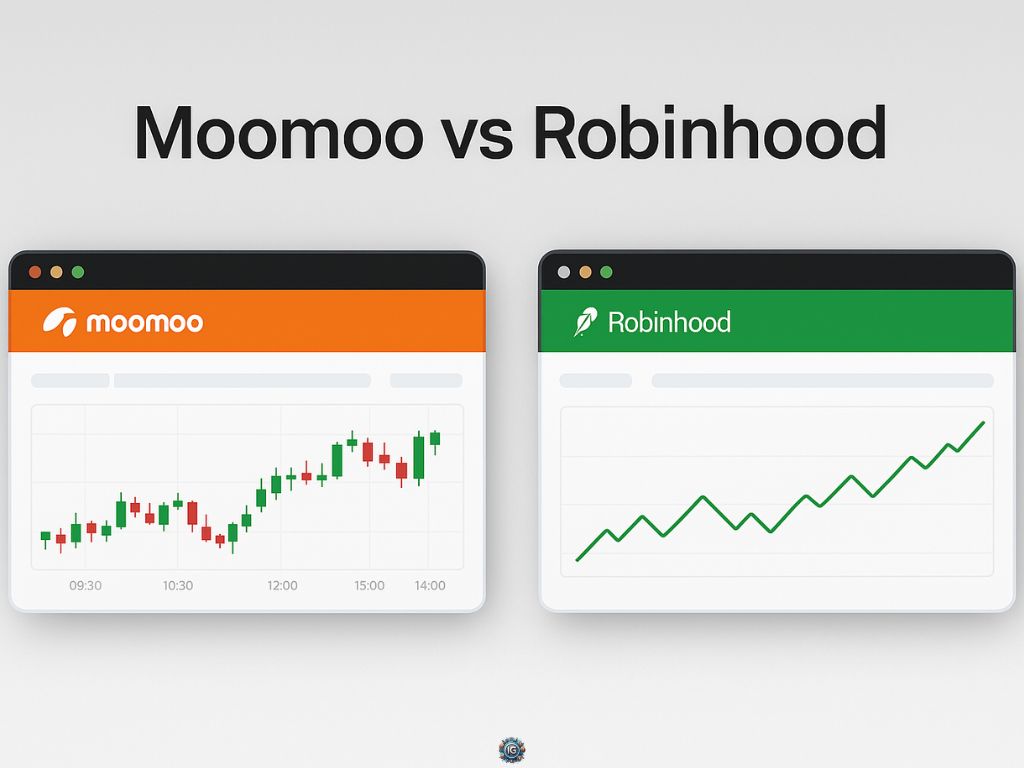
Which Trading App Is Right for You: Moomoo or Robinhood?
Forget features for a second. This is where it gets real.
You’ve seen the data, the tools, the fee breakdowns but none of that matters unless you pick the one that actually fits how you trade.
Let’s make that decision stupid simple:
Choose Moomoo if…
- You’re an active trader who lives in technical charts, scanners, and real-time data
- You want access to international stocks (Hong Kong, China A-shares, APAC ETFs)
- You value transparency in execution, Level 2 quotes, and multi-leg options strategies
- You’re not afraid of a learning curve if it unlocks more control and depth
- You want real IPO access, not a glorified waitlist
- You treat trading like a skill not a weekend hobby
Bottom line: Moomoo is built for power users. If you want a serious platform that goes beyond pretty charts, this is it.
Choose Robinhood if…
- You’re new, or just want the easiest way to get in and trade
- You like fractional shares and don’t want to think about whole stock prices
- You want crypto in-app and don’t care about custody
- You need instant deposits and clean, swipe-friendly design
- You’re building a basic portfolio with U.S. stocks and ETFs
- You want trading to feel smooth, fast, and frictionless without all the extra tools
Bottom line: Robinhood is ideal for minimalists and new investors. If you want less complexity and more speed, it’s hard to beat.
Or… Use Both Like a Pro
This isn’t a binary choice.
- Use Moomoo for: deep analysis, IPOs, scanning setups, international trades
- Use Robinhood for: fast execution, small trades, and in-app crypto access
Smart traders let tools play to their strengths. Use both just use them intentionally.

Frequently Asked Questions
What’s the main difference between Moomoo and Robinhood?
Moomoo is designed for active traders who want advanced tools, deep market data, and access to global exchanges. Robinhood is built for simplicity and speed, focused on U.S. markets and user-friendly trading.
Can I trade crypto on Moomoo?
No. Moomoo does not support crypto trading for U.S. users. If crypto is essential, Robinhood is your only option between the two though you’ll be trading through spread-based pricing, not full asset ownership.
Does Moomoo offer fractional shares?
No. Moomoo requires full-share purchases. Robinhood, on the other hand, allows fractional investing starting at just $1 ideal for smaller portfolios or high-priced stocks.
Which platform is better for options trading?
Both offer $0 options contracts. But Moomoo offers more technical overlays, volatility tools, and better order controls. If you’re running anything beyond basic calls and puts, Moomoo gives you more edge.
Is my money safe on these platforms?
Yes. Both Moomoo and Robinhood are regulated by FINRA and the SEC, and both are SIPC members, which means your account is insured up to $500,000 (including $250,000 for cash). Just don’t confuse that with FDIC insurance these are brokerage protections, not bank guarantees.
Can I use both apps at the same time?
Absolutely. Many traders use Moomoo for research and analytics and Robinhood for quick U.S. stock or crypto trades. There’s no rule saying you have to commit to just one.

Conclusion
Moomoo vs Robinhood isn’t a fight between good and bad — it’s a choice between depth and simplicity.
If you’re a trader who thrives on screeners, charts, execution data, and multi-market access, Moomoo is the obvious choice. It’s powerful, underrated, and built for those who treat trading as more than just a hobby.
If you value a clean interface, quick trade access, and crypto support inside one app, Robinhood delivers speed and convenience without overwhelming you. It’s ideal for new investors and minimalist portfolios.
Still Unsure? Here’s What You Can Do Right Now:
- Try paper trading on Moomoo test the interface, run some setups, see if it fits your rhythm
- Use Robinhood for small positions or crypto buys get a feel for speed and simplicity
- Compare current promos or referral offers some users may qualify for free stocks or bonuses on signup
- Open both (they’re free to set up) and let your trading style decide what sticks
Your trading tools shape your outcomes. Choose the platform that matches the way you think, move, and build.
Next: Check out our comparison between Moomoo and Webull.
Discover How Your Phone Could Be Paying You Daily!
Done-For-You ISH...

1 thought on “Moomoo vs Robinhood: Don’t Pick Without Reading”